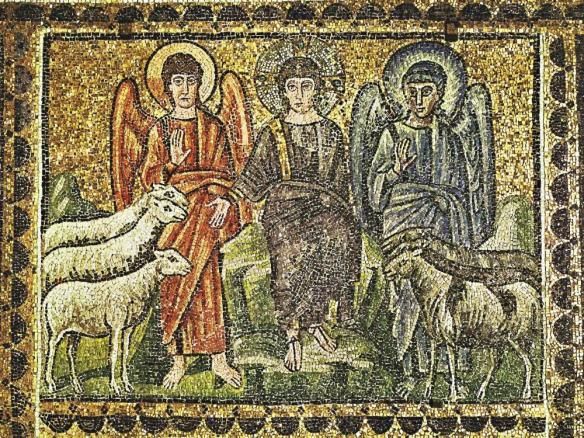
Fourth Sunday of Easter
Gospel according to John 10:27-30
Jesus said: “’My sheep hear my voice. I know them, and they follow me. I give them eternal life, and they will never perish. No one will snath them out of my hand. What the Father has given me is greater than all else, and no one can snatch it out of thew Father’s hand. The Fathe rand I are one.’”

Reflections
What a short Gospel reading for the Fourth Sunday of Easter! During the past three weeks, we have been intensely focusing on Jesus’ resurrection and the accounts of His appearance to the disciples. The first two readings this Sunday continue to describe the Apostles’ journey from Jerusalem to Antioch and Iconium, following Christ’s resurrection.
Paul, formerly known as Saul, a Pharisee and student of Gamaliel, converted on the road to Damascus, Syria, when Jesus mysteriously appeared and asked him why he is persecuting Him (Acts 9). He went into Damascus where he was met by the believers there and asked to be seen by Peter. Baptized by Ananias, and given the name Paul, his conversion is a powerful story of grace and redemption, illustrating that nothing is impossible for God when it comes to speaking to the heart (Acts 9:20-22). In unexpected ways, God can call people to His service.
Peter remained in Jerusalem, until he travelled to Joppa, Caesarea, and later to Rome, where he became the head of the first Chistian community. (1) He was crucified in Rome and after his death, St. Linus became Pope from AD 68 until his death is AD 76. This first ten popes in order were the following: St. Peter (32-67); St, Linus (67-76)’ St. Cletus (76-88); St. Clement (88-97); St. Evaristus (97-105); St. Alexander (105-115), St. Sixtus (115-125); St. Telesphorus (125-136); St Hyginus (136-140) and St. Pius (140-155). (2)
St. Paul was a convert, and he is also known as the Apostle of the Gentiles. (3) Initially traveling with Barnabas, they always addressed the local Jewish assembly and preached to them the Good News. When they did not have a good reception, they continued to move through the region and preached to Jews and gentiles. Eventually, Paul also reached Rome, and he was executed the same year as Peter, at the order of the Emperor Nero, during the persecution of the Christians in 64-67 AD. (4) Today, the Basilica of Saint Paul Outside the Walls” stands over the marble tomb that contains the remains of St. Paul. (5) The main altar of St. Peter’s Basilica in the Vatican stands over the tomb of St. Peter. (6)
The Second Reading by Saint John in Revelations 7:9, 14b-17 presents the image of the Lamb who is the shepherd of God’s people who will be sheltered; “…they will hunger no more, thirst no more; the sun will not strike them, not any scorching heat; for the Lamb at the center of the throne will be their shepherd, and he will guide them to the springs of the water of life, and God will wipe away every tear from their eyes” (Rev. 7:16-17). The words of the Gospel coincide with this section of the Revelations when Jesus says, “’My sheep will hear my voice’…’I give them eternal life, and they will never perish’…’The Father and I are one’” (John 10:27-30)
Where these two Apostles were laid to rest--Peter, the Leader of the Apostles, and Paul, the Apostle of the Gentiles--and the foundations of the Catholic Church emerged, the Cardinals elected a new Pope. After the death of Mons. Jorge Mario Bergoglio, Pope Francis, the 266th Pope of the Catholic Church, on April 21, 2025, on May 8th, 2025, the Cardinals elected Roberto Franciso Martinez Prevost to become the 267th Pope of the Church. He chose the name Pope Leo XIV. An Augustinian scholar, devoted to prayer and the missions, Pope Leo XIV is the successor of Saint Peter, and the new leader of the Catholic Church.
Jesus entrusted “the keys of the kingdom of heaven” to Peter (Matthew 16:18-19) and asked him three times to “feed my sheep” (John 21:15-17). Through the teaching of the Magisterium, we have a reliable guidance to the Gospel and the way to eternal life, strengthened by the presence of Jesus in the Sacrament. This visible and invisible connection with God is the rock of our faith as the mission of the Church is ongoing until the end of times.
Sources
- Britannica (2025). Saint Peter the Apostle: History, facts, and Feast Day. Retrieved from: https://britannica.com. Accessed: May 9, 2025.
- Catholic Encyclopedia (2023). Chronological List of Popes. New Advent. Retrieved from: www.newadvent.com. Accessed: May 9, 2025.
- Catholic Encyclopedia (2023) St. Paul. New Advent. Retrieved from: www.newadvent.com. Accessed: May 9, 2025.
- Catholic Encyclopedia (2023). The Acts of Peter and Paul. Retrieved from: www.newadvent.com. Accessed: May 9, 2025.
- Holy See (2025). The Papal Basilica: St Paul Outside-the-Walls. Retrieved from: https://www.vatican.va/various/basiliche/san_paolo/en/basilica/tomba.htm Accessed: May 9, 2025.
- Zander. P. (2025). Basilica Di Sant Pietro. The Tomb of Saint Peter. Retrieved from: https://www.basilicasanpietro.va/en/san-pietro/the-tomb-of-saint-peter. Accessed: May 9, 2025.